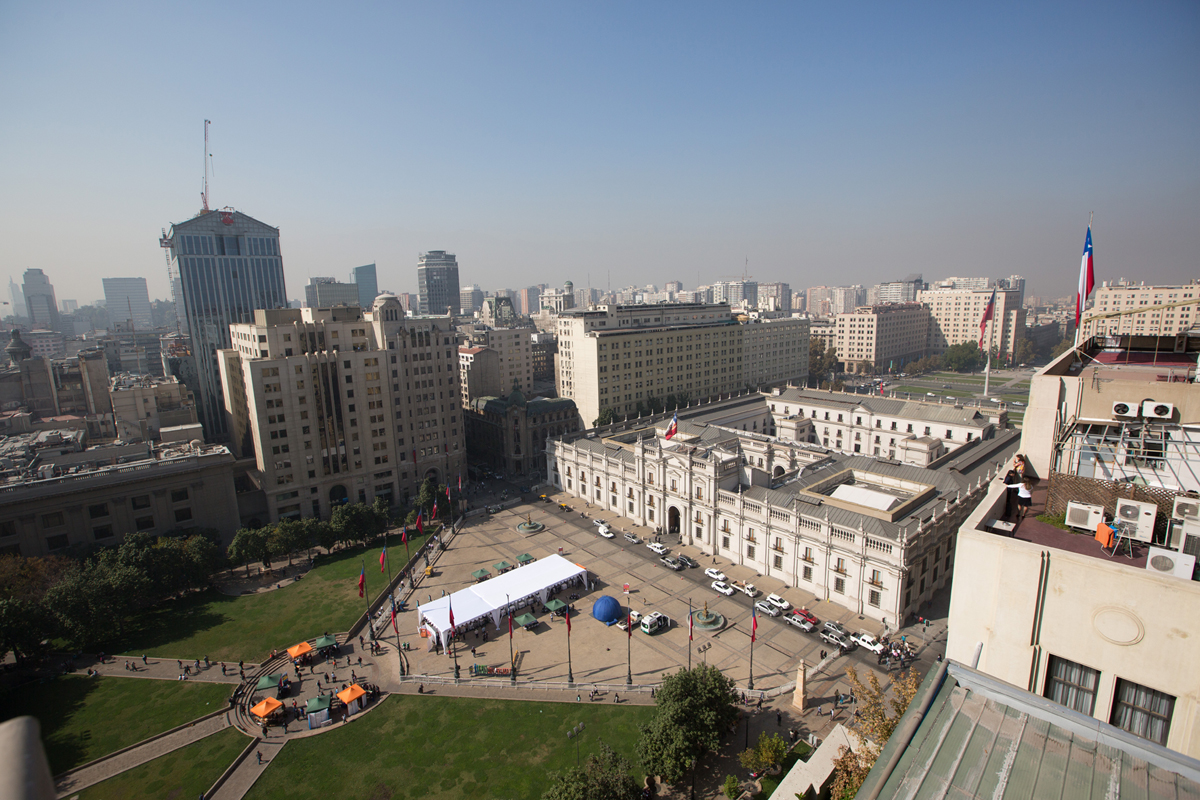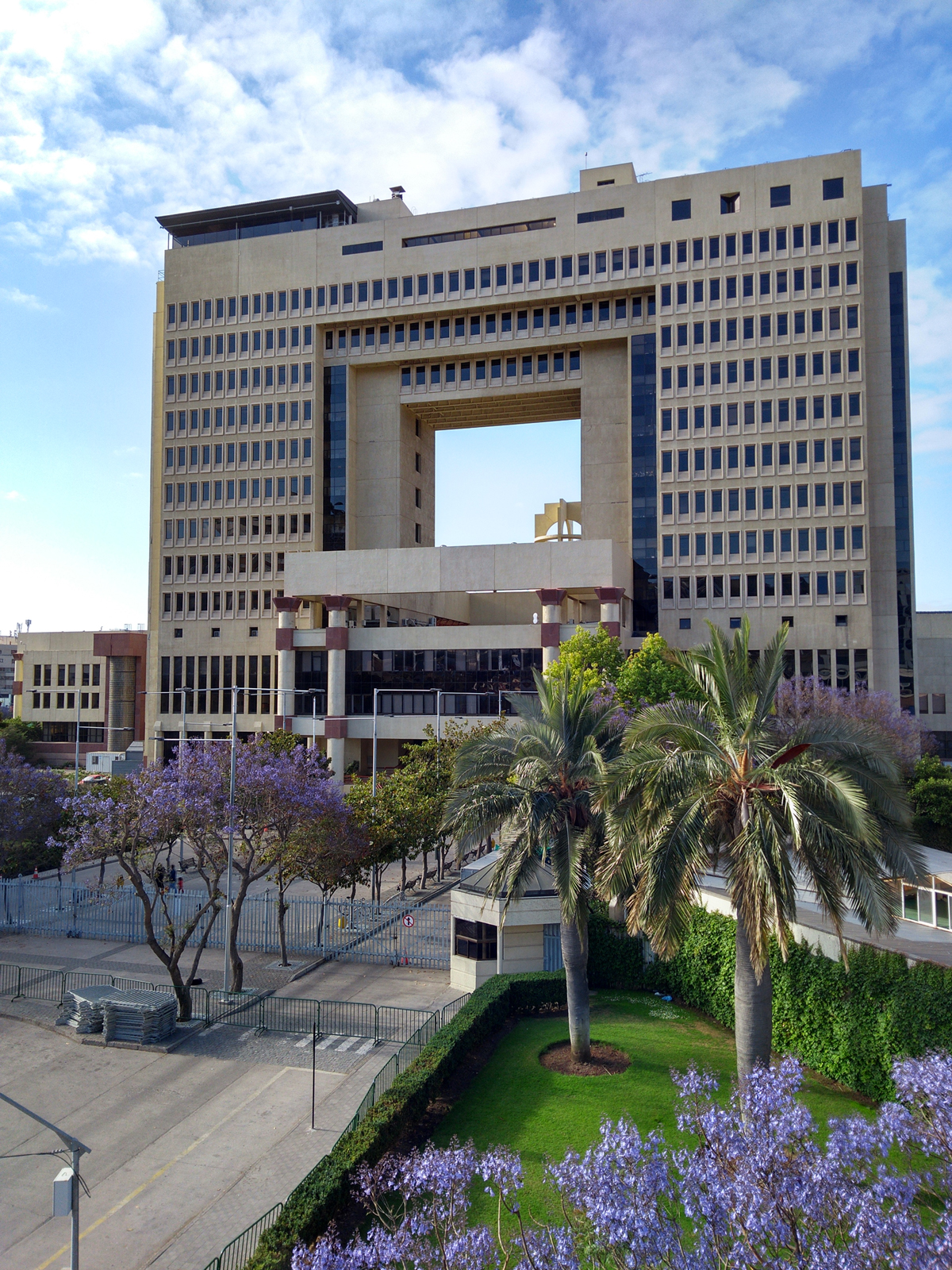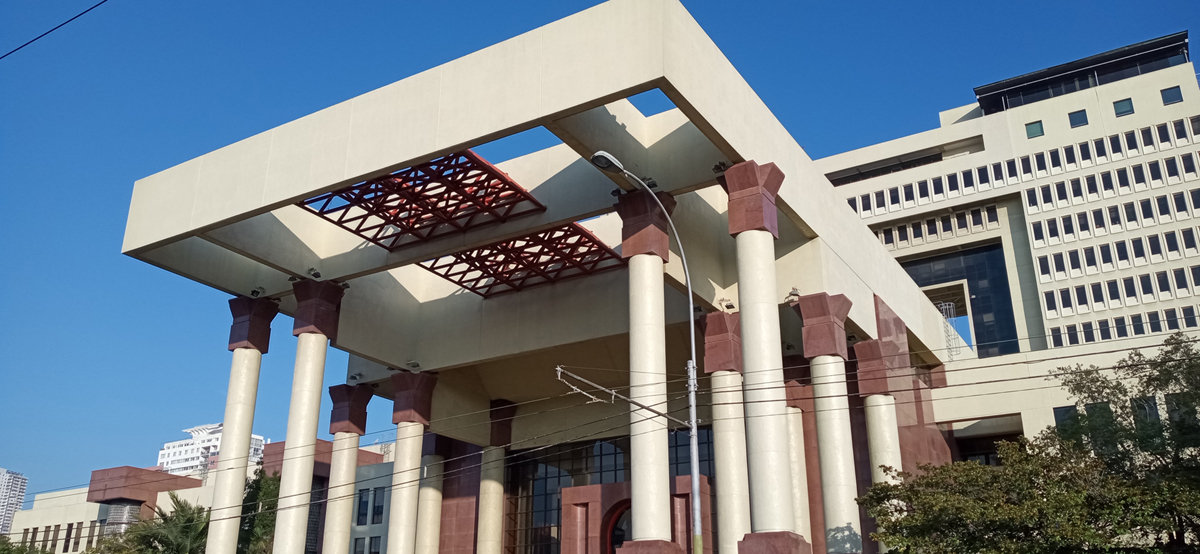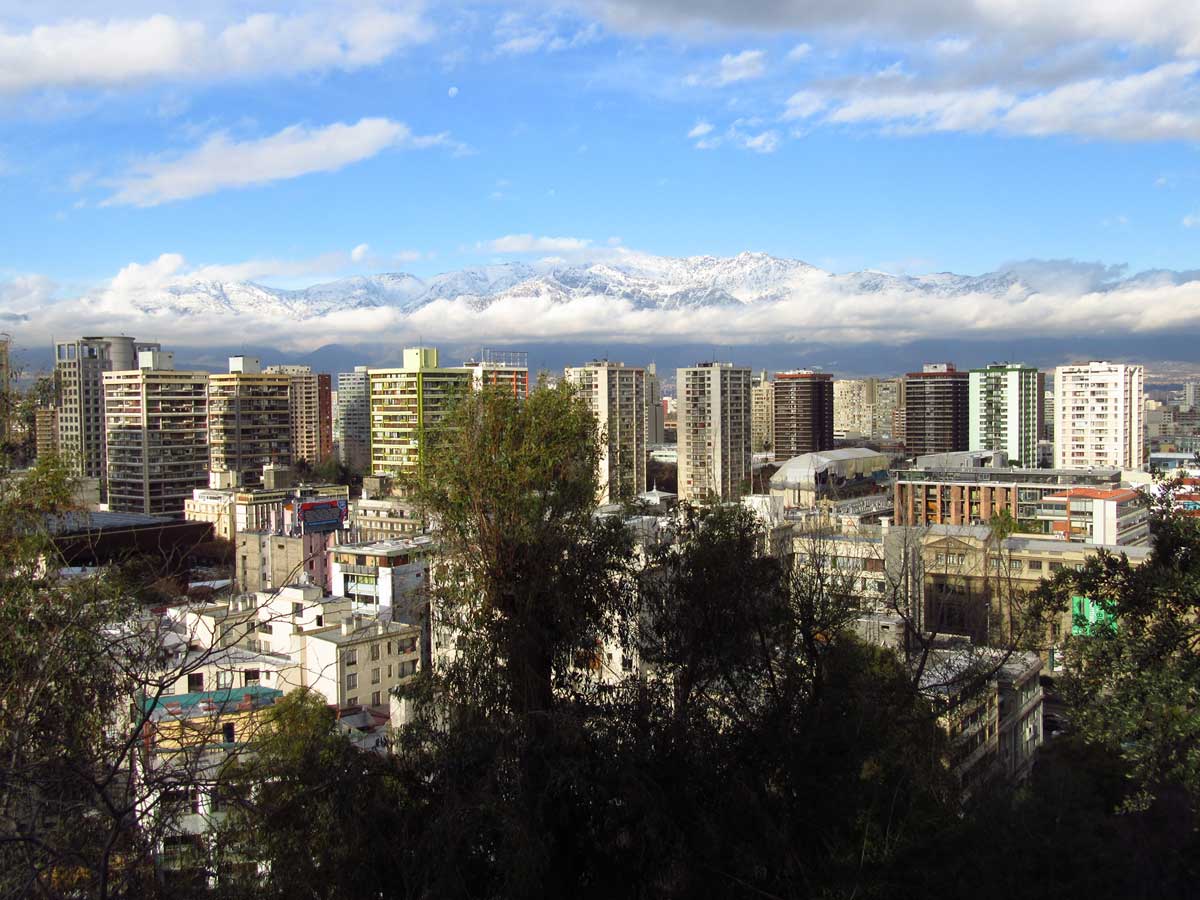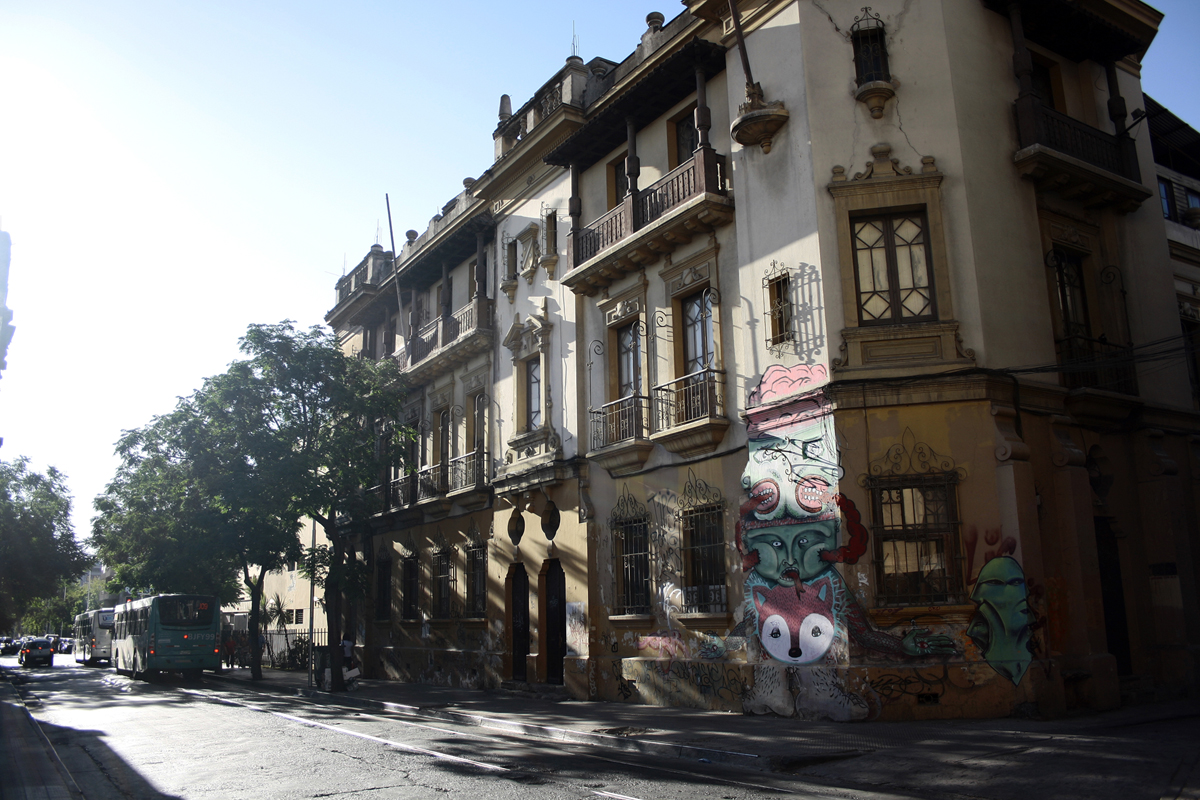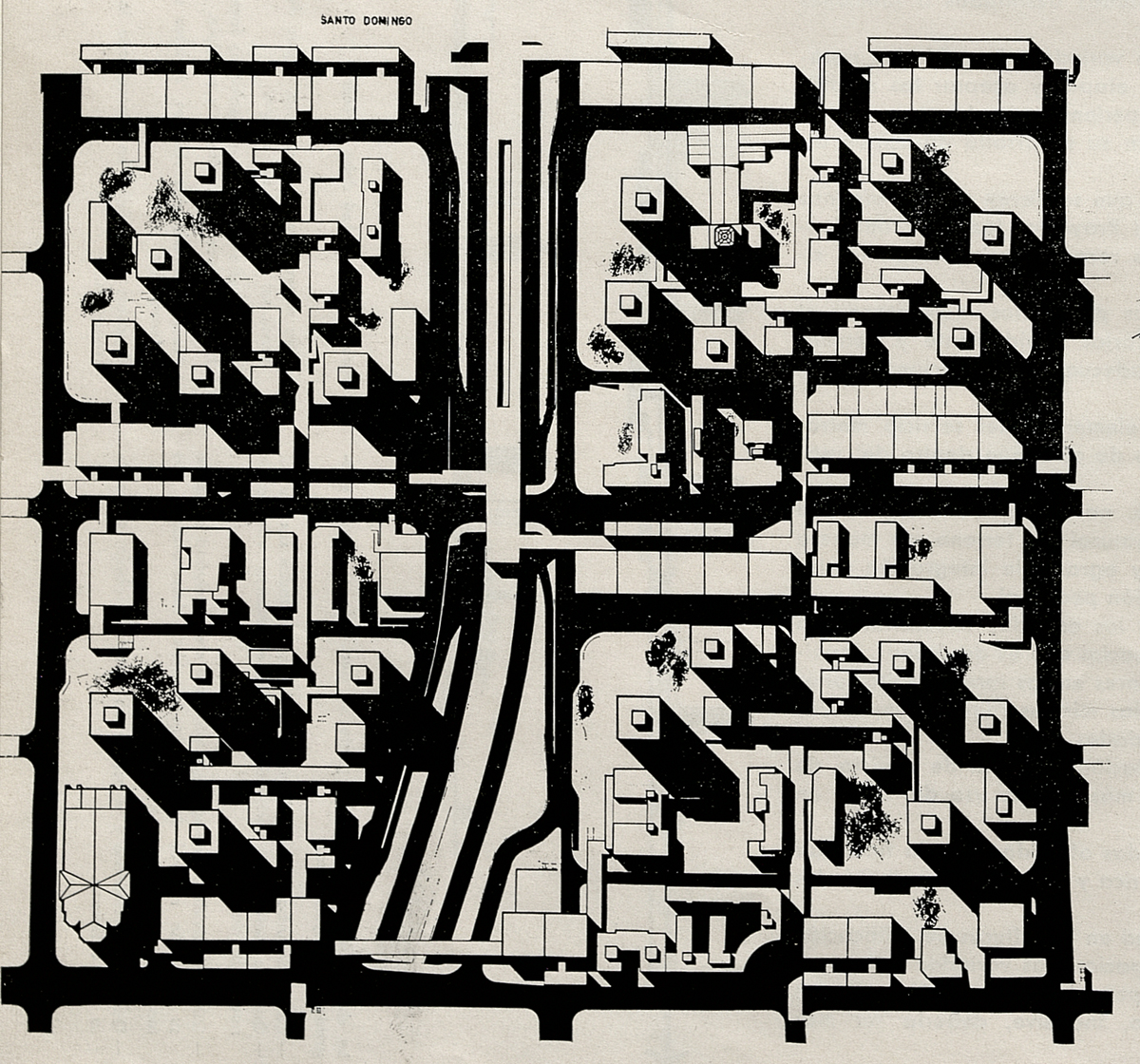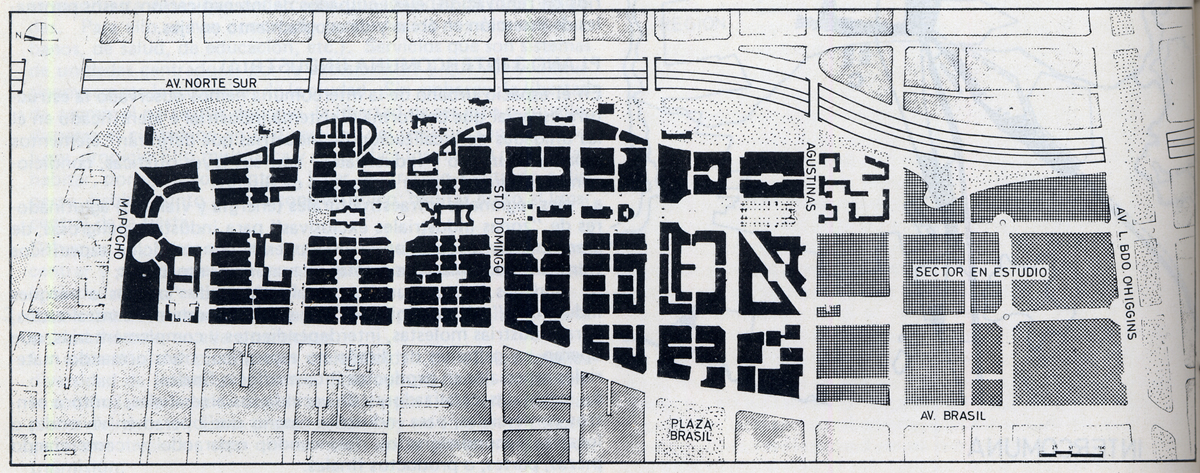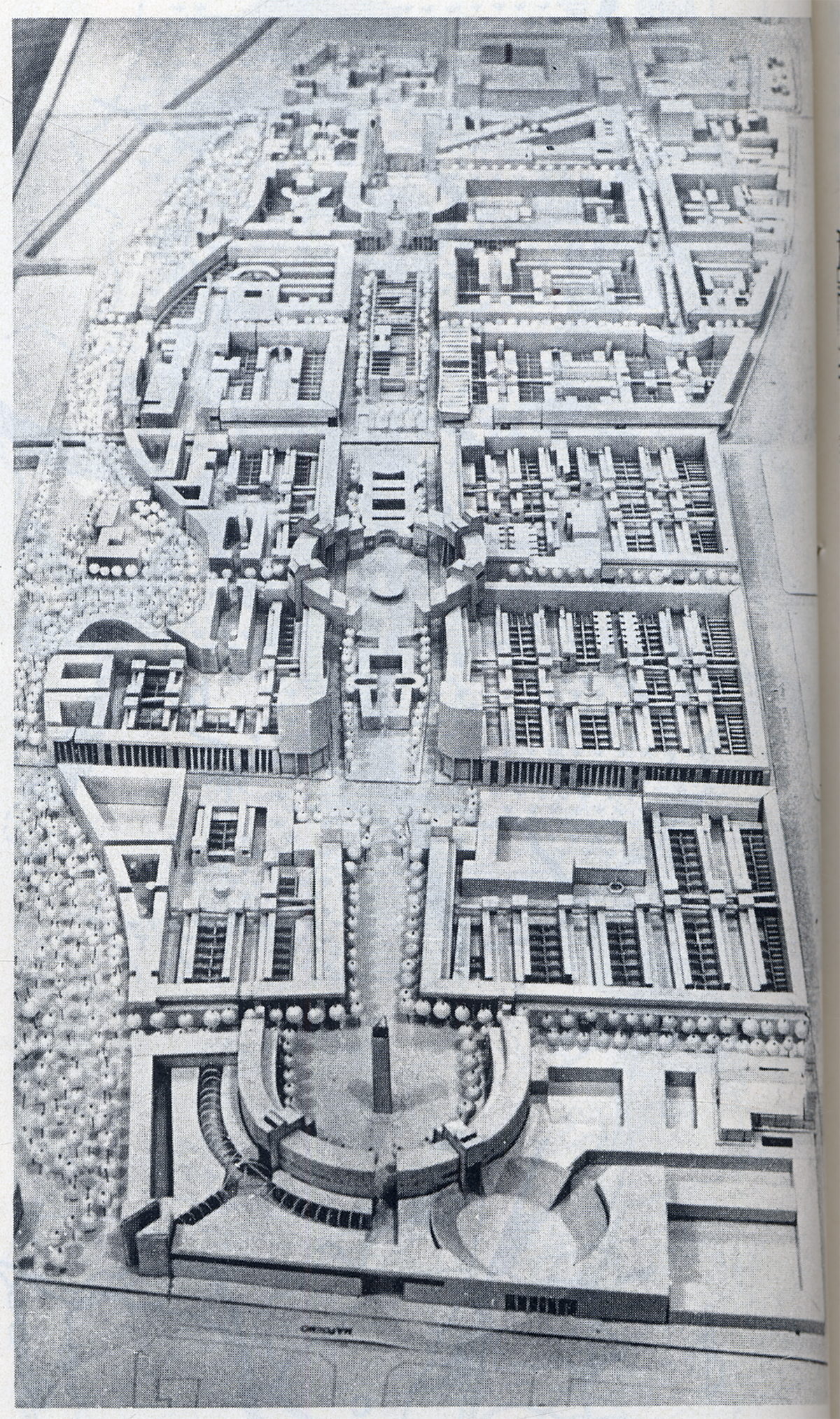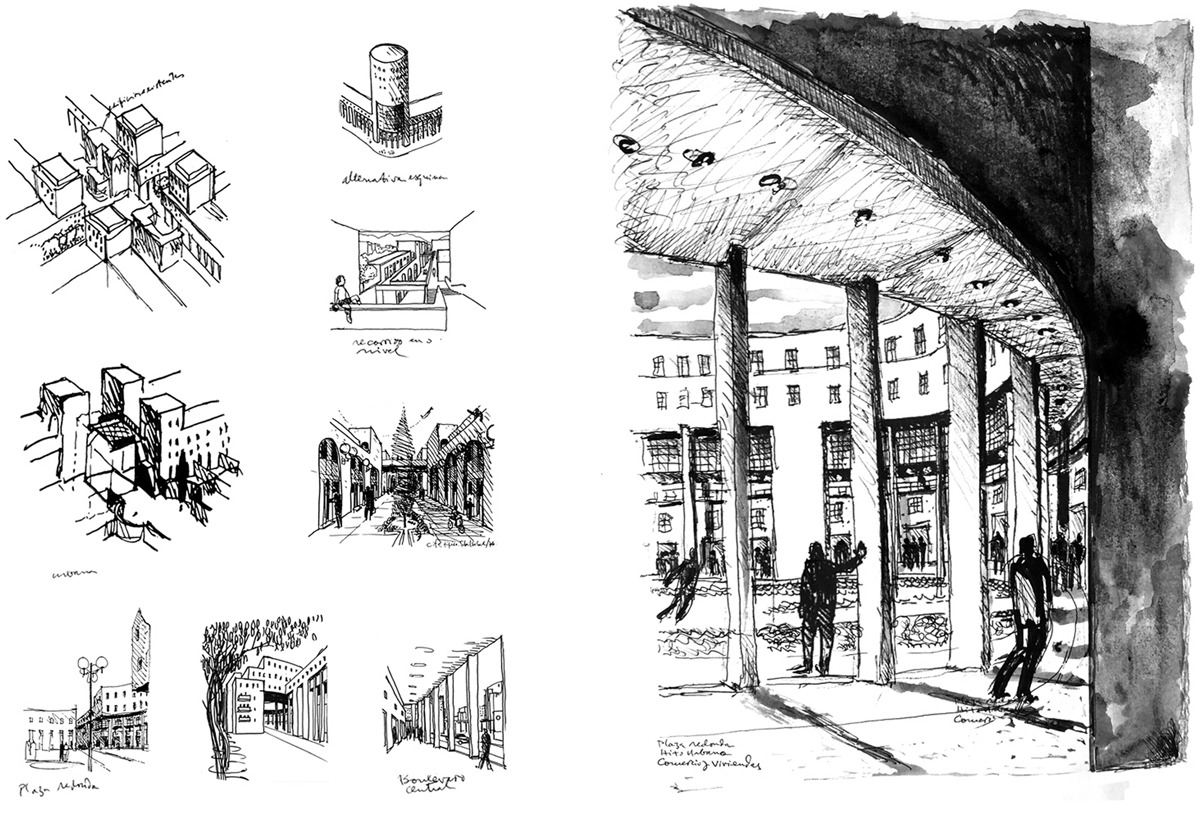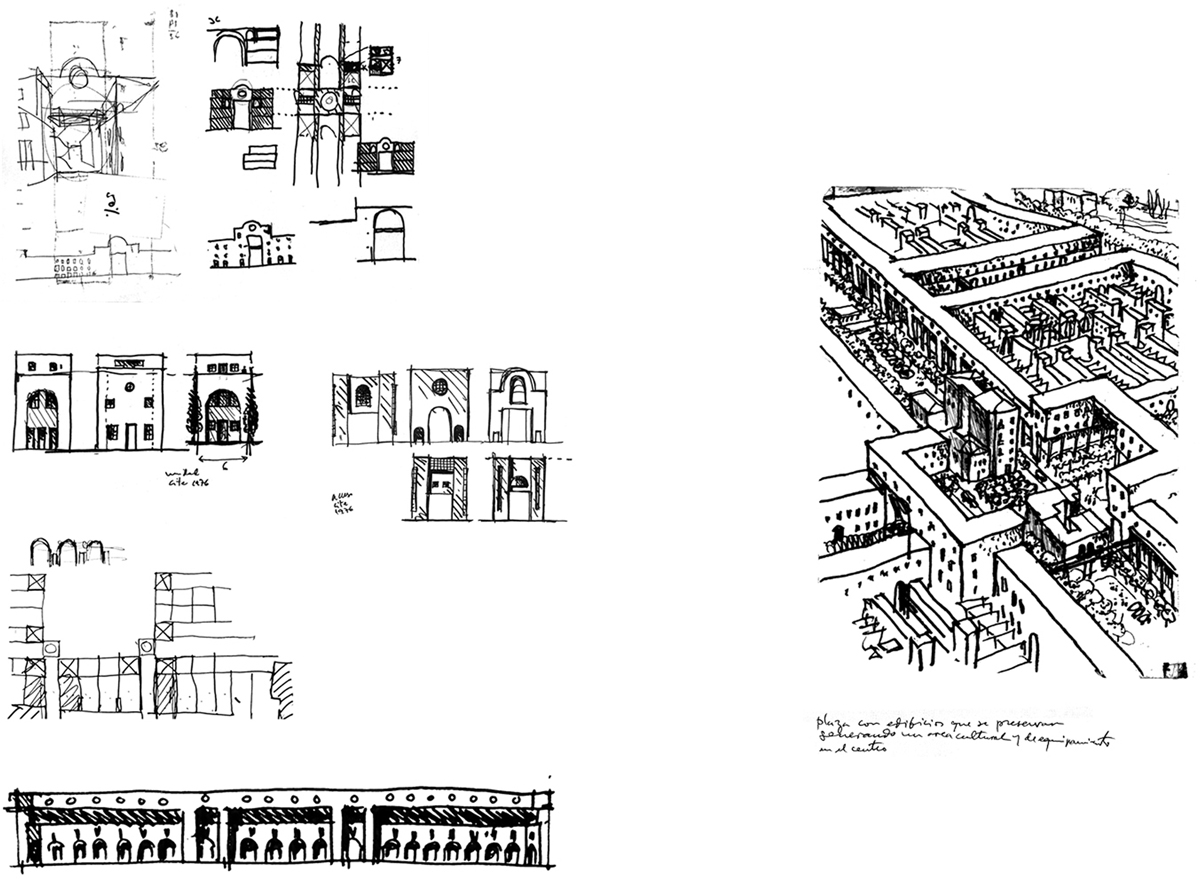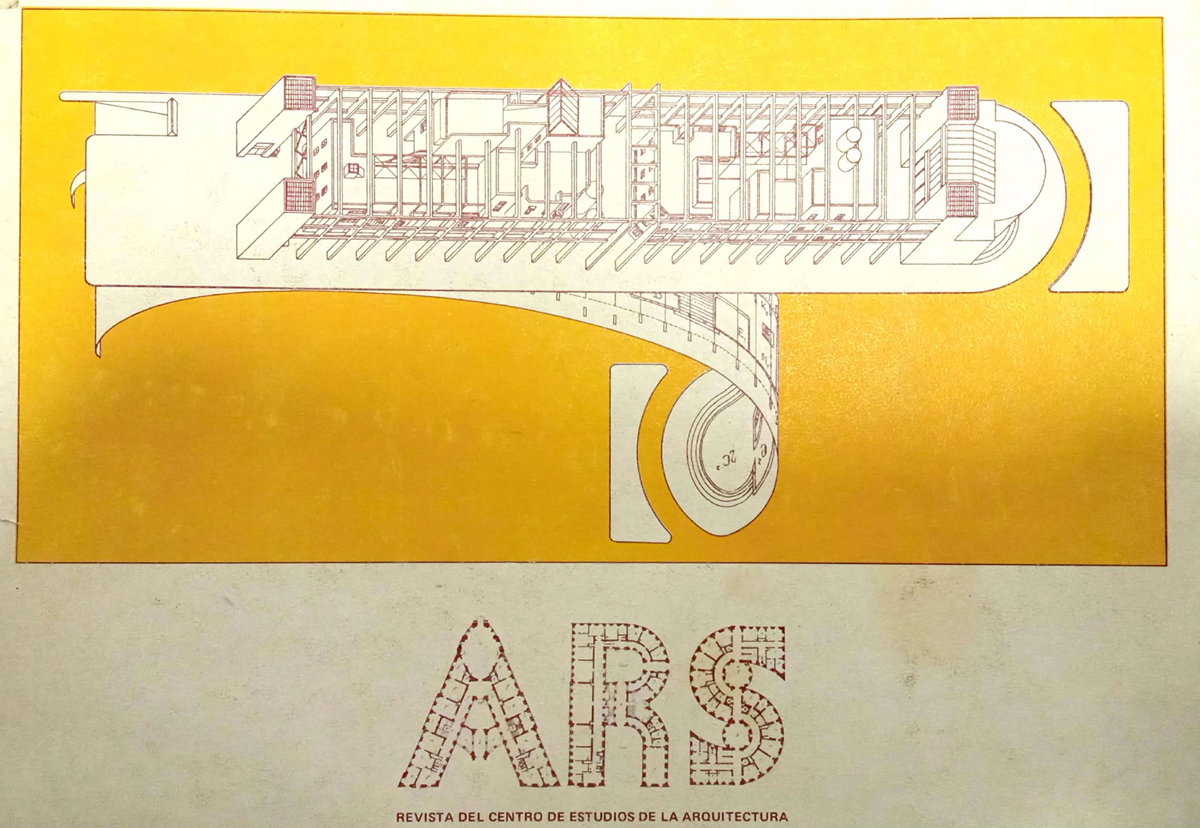Introduction
This article aims to complicate the still-prevailing narrative of postmodernism as passive and politically indifferent by looking beyond the examples from Western Europe and North America that tend to dominate analyses of postmodernism. Various recent conferences and symposia, including ‘Intersections: Late Socialism and Postmodernism’ (MIT 2012) and ‘Re-framing Identities: Architecture’s Turn to History, 1970–1990’ (ETH Zurich 2015), and book publications like Second World Postmodernisms: Architecture and Society Under Late Socialism (2019), edited by Vladimir Kulić, have demonstrated how focusing on postmodernism in historically marginalized locations reveals complex stories about the relationship between architecture and the state. This present essay contributes to the critical push to expand the geographic horizons of the study of postmodern architecture in order to rethink its connotation with the apolitical by examining Chilean postmodernism during the neoliberal dictatorship of Augusto Pinochet (1973–1990).
Postmodern architecture is traditionally understood as a reaction to the late phase of modernism, characterized by a departure from the progressive ideals embedded in modernist architecture. In its refusal to take a political stance, it has tended to be understood as inherently socially and politically conservative, following Jürgen Habermas, and as ‘the new corporate style’ of neoliberalism that ‘affirms a status quo’ through its ‘passivity vis-á-vis economic and political power’ (McLeod 1989: 29, 38), and as following the ‘cultural logic of late capitalism’, as elaborated by Fredric Jameson. These diagnoses of postmodernism have been increasingly contested in recent years, as in Emmanuel Petit’s Irony; or, the Self-Critical Opacity of Postmodern Architecture (2013), in which the author rethinks the function of irony in postmodernism, or in Sylvia Lavin’s exhibition, Architecture Itself and Other Postmodernist Myths (2018–2019), which has attempted to destabilize the historiographic narrative of postmodernism by tracing the processes of ‘postmodernization’. Postmodernism is one of the most elusive terms in architectural history. While it is often described as a style, for the purpose of this study it is more useful to consider it, following Jameson, as ‘a conception which allows for the presence and coexistence of a range of very different, yet subordinate features’ (1990: 4). While, as we will see, Jameson’s understanding of postmodernism as symptomatic of late capitalism does not fully apply to the examples discussed here, his description of postmodernism as a current or tendency distinguished by the presence of certain theoretical and formal qualities to be used selectively will be helpful for identifying and discussing architectural practices analyzed in this article.
Chilean postmodernism of the 1970s and 1980s is profoundly imbricated in political projects with the government’s agenda and with efforts oppositional to Pinochet’s dictatorship. In projects such as Plaza de la Constitución (Constitution Square) in Santiago de Chile (1980–1982) and the Congreso Nacional de Chile in Valparaíso (1988–1990), realized in times of increasing resistance against Pinochet, postmodernism was used as a form of propaganda by the regime to project a false image of an open, democratic country. At the same time, postmodernism was used by architects opposed to the regime. An example can be seen in the work of the Centro de Estudios de la Arquitectura (CEDLA), an independent collective of Chilean architects established in 1977 in Santiago de Chile by Humberto Eliash, Cristián Boza, and Pedro Murtinho.1 Through their projects, publications, organized conferences, and symposia, CEDLA interpreted postmodernism subversively and used postmodern concepts — such as the revival of traditional urban forms — as tools to foster community and social bonds that would eventually contribute to overturning the regime and to the return of democracy.
Chilean architecture, due to its political-economic context, allows us to emphasize the political dimensions of postmodernism. First, the Chilean (laissez-faire) economy between 1973 and 1990 was not politically neutral but needed to be actively defended and propagandized; as a result, postmodernism became both a passive byproduct and an active contribution of the government. Chile thus helps us see how the capitalist context means that postmodernism is political, for in this case, the neoliberal ideology needs to be defended (and is indeed contested). At the same time, in designs that work against the government, we see the pro-social potential in postmodernism at work, particularly in uses of traditional typologies.
The Chilean architects analyzed in this paper understand postmodernism through its criticism of dogmas associated with modern architecture and urban planning — for instance, modern architecture’s pursuit of universal comprehensive solutions with the pretense of objectivity, its emphasis on the primacy of expert architectural knowledge over the needs of the inhabitants, its foregrounding of technocracy and standardization, and its disregard for history over affirming the present. In contrast to those principles, these Chilean architects pursue the idea of architecture based on traditional typologies in which symbolic and image-making potential are as important as function and structure. While none of the architects formulate a coherent definition of postmodernism to describe their work, they use the concepts, ideas, and formal solutions introduced by such authors as Charles Jencks, Léon and Rob Krier, Paolo Portoghesi, Aldo Rossi, and Robert Venturi.2 The designs discussed in this article use key tropes of postmodernism promoted by these authors in familiar yet different ways. In Chilean propagandistic realizations, qualities theorized and utilized by postmodernists, such as irony, the symbolic potential of architectural form, and references to architectural tradition, are used, paradoxically, not to make these buildings relatable, familiar, and connected to the community, but rather to distract from the disgraced legacy of the dictatorship and to fabricate a vision of history desirable for the regime. At the same time, in designs intended as oppositional, symbolic forms and the use of traditional typologies are used for contrasting ideological goals: They seek to promote democratic and politically and socially engaged visions of society that could counter the neoliberal agenda of Pinochet. In these ways, core elements considered synonymous with postmodernism play complex political roles, producing a postmodernism that is in important ways out of sync with its dominant historical theorizations.
Architecture in Pinochet’s Chile, 1973–1990
After Pinochet toppled the socialist government of Salvador Allende with the coup d’état of September 11, 1973, Chile implemented harsh neoliberal reforms. The militarization of the government and its apparatuses was combined with a strong agenda of privatization and deregulation, such that the social and economic efforts of Pinochet’s administration were focused on reversing the pro-social policies of the previous governments of Eduardo Frei Montalva (1964–1970) and Allende (1970–1973). This radical shift in approach influenced Chilean architecture and urban space. Pinochet eliminated state agencies responsible for urban planning and social housing and, in 1979, adopted a law stating that ‘urban land is a resource which can be traded freely’, which entailed zoning laws shaped by the demands of the market.3 Another crucial aspect of the privatization of architecture and the city under Pinochet’s dictatorship was the approach to housing, which increased segregation and social inequality. Built by private construction companies instead of the state, housing projects were designed to maximize profit rather than to promote social good. The urban poor were resettled away from people with higher incomes, and newly commissioned social housing settlements were typically make-shift solutions in remote locations lacking proper infrastructure, characterized by low-quality architecture. While for the governments of Frei and Allende housing was a universal human right protected by the state, Pinochet considered housing a commodity that should be ruled by the principles of supply and demand.4
The new administration’s regulations and policies thus undeniably had a significant effect on the urban planning and architecture produced under the dictatorship. Despite the absence of any official declarations that would prove Pinochet’s direct interest in architecture, this approach (which was consistent with the newly adopted philosophy of laissez-faire) determined the nature of architecture in post-coup Chile. The privatization-oriented policies and economic reforms of the new government led to the emergence of architectural formats new to (or at least not previously popular in) urban space in Chile. Just as the eras of Frei and Allende were represented by late modern social housing and public buildings, the architecture of Pinochet’s time was defined by banks, hotels, headquarters of private (or newly privatized) companies, and shopping centers. Given that these buildings, burgeoning in the 1970s and 1980s, drew abundantly from the postmodern aesthetic repertoire, postmodernism would come to be widely interpreted by many Chilean architects and architectural critics as a style of Pinochet's time.5 Moreover, Chilean architecture of these decades not only reflected economic and social changes implemented by Pinochet but also actively contributed to these changes. Writing about postmodern corporate buildings in Santiago, architectural historian and theoretician Daniel Talesnik characterizes them as instrumental in creating a new, neoliberal image of Chilean capital (2021). Architectural critic Liliana de Simone similarly describes new types of commercial centers in Pinochet’s Chile as signs of ‘awaited and expected progress, imbued with the discourses of modernization advocated by the military regime’ (2012). Postmodern forms in banks, hotels, and other commercial buildings and spaces populating Chilean cities in the 1970s and 1980s aided the government’s political agenda as they helped to normalize painful neoliberal reforms and create an image of prosperity and progress. In this sense, we can understand Chilean postmodern commercial architecture as an active agent responsible for normalizing and validating dramatic social, economic, and political changes.
Even though Pinochet’s government did not formulate any direct program or guidelines regarding architecture, it had a clear preference for historicizing postmodern forms. This is apparent in the results of public architectural competitions organized during Pinochet’s reign. The two most important of these concerned symbolically and politically charged sites of high significance: the Plaza de la Constitución in Santiago de Chile (1980, organized by the Municipality of Santiago), and the Congreso Nacional de Chile (1988) in Valparaíso. Both winning proposals were intended to mark two of the most significant political events in post-coup Chile and were based on postmodern forms and ideas.
Plaza de la Constitución
The Plaza de la Constitución occupies one hectare north of the entrance façade of the neoclassical presidential Palacio de la Moneda in the heart of Santiago de Chile. Due to its prominent location, Plaza de la Constitución had been used as a space for social and political demonstrations, but on a day-to-day basis served as a large parking lot. From 1973 on, Plaza de la Constitución increasingly took on new meanings. On September 11, La Moneda, bombed and attacked with tanks, became the main site of the coup. After the coup and for the following eight years, La Moneda ceased to serve as the presidential palace, and for a time the regime used its basement as a secret torture chamber for political opponents (Rabascall 2016). In 1980, the Municipality of Santiago announced a public competition for the renovation of Plaza de la Constitución (Undurraga and Devés 1981: 8). The timing of the renovation was closely connected to the announcement of the new constitution, approved in a controversial referendum held on September 11, 1980, which introduced a model of democracia protegida (protected democracy), a neoliberal vision of democracy in which economic progress is seen as the main goal and in which political pluralism and citizens’ influence over decision-making are heavily restricted. The constitution contained temporary articles that ensured Pinochet would remain in power for at least eight more years.
The competition was won by the office of Cristián Undurraga and Ana Luisa Devés — architects known for their postmodern preferences. Their project was based on a simple layout with a clear reference to historical urban typologies (Figure 1). According to the new design, the square is divided into four parts by two diagonal lines constituting paved pedestrian paths, connecting in the middle at a circular, slightly sunken paved plaza. As a result, the Plaza de la Constitución was divided in four triangles. The triangle before the entrance to La Moneda is paved, and the remaining three are covered with grass. An additional pedestrian path on the side of the center circle opposite the paved triangle runs perpendicular to the façade, emphasizing the bilateral symmetry of the design. The utterly traditional form of the Plaza de la Constitución — recalling an array of historical associations, from idealized Italian renaissance urban designs to the regularity of French baroque formal gardens — corresponds with the neoclassical form of the palace. Because of the simplicity of the design, traditional typologies — path, plaza, and court — are exposed and presented in a distilled, purified form. For these reasons, the Plaza de la Constitución is often described as one of the most decisively postmodern realizations in Chile (Díaz et al. 2008).
Right: Joaquin Toesca, Palacio de la Moneda (1784–1805); center: Cristián Undurraga and Ana Luisa Devés, Plaza de la Constitución (1980–1982). Photo: Maina Kiai, 2015. Wikimedia Commons, License: Attribution 2.0 Generic (CC BY 2.0), https://es.wikipedia.org/wiki/Plaza_de_la_Constituci%C3%B3n_%28Santiago_de_Chile%29#/media/Archivo:View_of_the_Palacio_de_la_Moneda_in_Santiago,_Chile_(17124202170).jpg.
The new design effectively erased the democratic character and violent history of the previous space. Unruly and unregulated, the pre-1973 Plaza de la Constitución responded to citizens’ needs, from manifesting dissent and opinions on current political events to performing the mundane and ordinary function of providing parking spaces. The new design did not maintain any connection with the people, its ceremonial and official character resembling more of a baroque cour d’honneur (court of honor) than a civic space. More importantly, the historicizing design of Undurraga and Devés erases memory, covering up the darkest history of the space with clean, elegant forms. The Plaza de la Constitución subverts key postmodern tropes of history, memory, and genius loci. It erases the existing memory and character of the space and replaces them with an idealized and purified version of history. While postmodernists usually advocated for using historicizing forms to make architecture more relatable and familiar, Undurraga and Devés reversed this logic. In the Plaza de la Constitución, historical references are employed to replace real and living memories with forms that are conveniently (for the government) abstract and distant to detract attention from trauma by bringing up a vague and innocuous history and tradition that fit into Pinochet’s intended image.6
Historian Steve Stern interprets the new urban realization of the Plaza de la Constitución as a ‘part of the military regime’s institutionalization project and celebration of a new Constitution’, which deliberately silenced the collective memory of the space (2010: 266). The significance of the new design was well captured by a representative of Human Rights Watch, who in 1988 was delegated to report on the human rights situation in Chile:
I looked down on Santiago’s famous Plaza de la Constitución, where citizens historically gathered to praise or protest the actions of their government. At first the expanse of grass in the plaza was pleasing, it was so green and neat. Then I remembered that it was Pinochet’s poorly paid minimum-work program for Chile’s large unemployed population that kept the parks so clean, indeed among the cleanest in the world. Pinochet had changed the layout of the plaza. More than two-thirds of the traditional cobblestone public space was now subdivided into a series of well-kept elevated grassy sections. Citizens could walk along the guarded pathways but not congregate in the plaza — discouraging to protest. (Stepan 1988)
Another crucial aspect of the treatment of history in Plaza de la Constitución is that, contrary to what we usually associate with postmodern practices, the classical references used are devoid of levity. Instead of performing erudite games and being subject to playful recontextualizations, quotes from the Italian renaissance and the French baroque are used to boost a specifically political image of grandiosity, authority, order, and power. An analogical treatment of historical references can be seen in another prominent commission: the Congreso Nacional de Chile.
Congreso Nacional de Chile
If the establishment of the new constitution in 1980 was one significant political event that Pinochet’s administration symbolically signaled through a work of postmodern architecture, the Chilean national plebiscite held on October 5, 1988, was another, as it would be accompanied by the new building for the Chilean Congress. The constitution had established the 1988 plebiscite eight years in advance, stating that it could result in one of two scenarios. If Pinochet were to be approved for another eight years after 1988 (until 1996), parliamentary elections would take place nine months after he was sworn into office. Alternatively, if Pinochet were to lose, both presidential and parliamentary elections would follow. As a part of the effort to present Pinochet’s government as ushering in a return of a legitimate democracy, in the years following the 1980 constitution, the administration introduced legislative changes in preparation for future free elections. This included reinstating the Congreso Nacional de Chile, which had been previously dissolved by Pinochet in 1973.
Because the old 19th-century Congress building located in Santiago needed renovation, planned elections sparked discussions regarding the space the Congress would occupy. In 1987, Pinochet’s administration announced the decision to erect a new building instead of renovating the old one. Moreover, it was decided that the new building would be in Valparaíso, the decaying port city located 77 miles from Santiago.7 The official reasons for the move were twofold: to decentralize power in Chile and to initiate an urban renewal of Valparaíso. Since Pinochet hoped to maintain power after the elections, both the declaration of decentralizing power and the implied message that the president cared about the forgotten parts of the country were intended to improve Pinochet’s image among voters.8 The reinstatement of the National Congress was a real legislative move as well as a symbolic gesture to open a new chapter in Chilean history. Erecting a new building in a new location rather than renovating the old one was a way to signal a new beginning for a disgraced dictatorship. Therefore, the propagandistic, image-building potential of the future seat of the Congress was crucial to its design.
The results of the national competition for the Congress building were announced on June 30, 1988, three months before the plebiscite’s results. The organizers (Dirección de Arquitectura de Ministerio de Obras Públicas [Architecture Department at the Ministry of Public Works] and Colegio de Arquitectos de Chile [Chilean College of Architects]) received 539 proposals. The winning entry was a design from Juan Cárdenas, José Covacevic, and Raúl Farrú.9 In the results statement, the organizers said that Cárdenas, Covacevic, and Farrú’s project ‘fully fulfilled the requirements asked in the commission: to project over Valparaíso’s plan a building of national and monumental character, and also austere, dignified, and transcendent, able to house the Chilean National Congress’ (‘Resumen de Presentación’ 1990: 29) (Figures 2 and 3).
Juan Cárdenas, José Covacevic, and Raúl Farrú, south view of the Congreso Nacional de Chile in Valparaíso (1988–1990). Photo: Unknown Author, 2017. Wikimedia Commons, License: Creative Commons Attribution-Share Alike 2.0 Generic. https://commons.wikimedia.org/wiki/File:Congreso_Nacional_de_Chile.jpg.
The massive building — 60,000 square meters — of the Congreso Nacional de Chile is divided into two main parts. The first part, which makes up the northern portion of the building, is four stories, housing the chamber of deputies, the chamber of senate, and the plenary room. The entrance to the building is in the center of this northern part and is emphasized by a large portico. The portico is covered with a massive grid-like roof supported by twelve columns with plain shafts recalling Doric order and stylized terracotta-red capitals loosely evoking Egyptian temples and the geometricized forms of art deco architecture. An additional four oversized columns, with shafts clad with charcoal tile and topped with red cuboid-shaped capitals, flank the entrance, two on each side. The second part of the Congress, which makes up the southern portion, is a fourteen-story tower behind the four-story edifice, housing offices, the library, and equipment and technical facilities. The tower is a large, monumental cuboid with a square-shaped opening in its lower middle part, resembling a simplified and magnified Arc de Triomphe, thoroughly dominating the surrounding landscape. This postmodern design, juxtaposing various historical references and freely mixing different colors and materials (dark-red stone, charcoal tiles, ocher concrete), pleased not only the jury, but according to architect Pablo Allard, also Pinochet himself, who said, ‘When I saw the models, I knew this was the winner’ (2012: 38).
In an article about the Congreso Nacional de Chile, Francisco Díaz describes the propagandistic function of the new building as an effort to signal ‘a new beginning for Chilean political history’ and an attempt to ‘clean up the past by merging it with the future’ (2013: 6–7). In this way the Congress building is analogous to the Plaza de la Constitución in its effort to ‘clean up the past’ through its classicizing design. As with Undurraga and Devés’s design, the Congreso Nacional de Chile utilizes historical forms that are distant, abstract, and idealized and refers to architectural tradition not to create a sense of continuity between the past and present or to anchor the building in the community it is supposed to serve, but to craft a desired image of dictatorship. Like the Plaza de la Constitución, the Congreso Nacional de Chile’s postmodern design evokes the grandiosity of classicism and thus responds to the commission’s request for a project that is ‘austere, dignified, and transcendent’, and departs from the ironic playfulness of Western European or North American postmodern projects. In addition, like the Plaza de la Constitución, the Congreso’s evident referentiality plays a significant role in projecting a crafted image of Pinochet’s regime. With its obvious throwbacks and recuperations of various styles, in line with current architectural trends, the building signals an aesthetic dynamism and an innovative and revived spirit to the Pinochet government. This self-consciously crafted perception inherent to Cárdenas, Covacevic, and Farrú’s design undoubtedly appealed to Pinochet’s commission because projecting a democratic and rejuvenated character was an essential goal of the government, which hoped to remain in power after the plebiscite.
Pinochet’s efforts to improve his image with a spectacular architectural symbol of his new pro-democratic orientation proved to be unsuccessful. In June of 1989, when it was known that Pinochet would be stepping down, the dictator traveled to Valparaíso to visit the construction site of the new Congress building. He arrived to a crowd of workers chanting ‘que se vaya!’ (leave/get out of here). As recorded in documented footage, Pinochet asked his team to take close-up pictures of protesting workers to identify them later.10 These commands were in fact nothing but empty threats and echoes of Pinochet’s former power, as it was clear that Chile had entered a post-dictatorial era.
CEDLA and Santiago Poniente
These two projects commissioned during Pinochet’s reign, one that marked the 1980 constitution and the other that marked the plebiscite, both employed postmodern forms in explicitly propagandistic ways. By evoking grandiosity and authority through classical designs and by utilizing a fashionable aesthetic to signal a spirit of innovation, the Pinochet government aligned postmodernism with its aims. At the same time, however, postmodern forms and ideology were used by Chilean architects who opposed Pinochet’s policies. The most significant example of designers who used postmodern notions and forms to foster social and political change against Pinochet’s regime was the group known as CEDLA, formed as an effort to reflect on architecture and urban planning in Chile under the military government. After the coup, Pinochet’s government replaced the authorities and some of the faculty of major Chilean universities, which, starting in October 1973, was governed by military officers appointed by Pinochet.11 Additionally, professional associations (including the Colegio de Arquitectos de Chile) were infiltrated by government nominations, and many left-leaning or openly socialist architects left the country. This does not mean that the Chilean architectural scene post-1973 consisted exclusively of people embracing Pinochet’s vision of privatized urban space. It also included architects who opposed the neoliberal paradigm, who started their careers under Frei or Allende, and who were associated with AUCA (Arquitectura, Urbanismo, Construcción, Arte), a left-leaning independent magazine existing from 1965 to 1986 strongly devoted to modernist ideals. CEDLA stands out as an organization that emerged out of a desire to oppose not only the neoliberal transformation of Chilean cities under Pinochet but also the modernist approach to city planning under Frei and Allende. While the members of CEDLA embraced the pro-social postulates of modernist architecture, including the conviction that architecture is a social service rather than a profit-driven commodity, they also opposed the rigidity, anonymity, and technocracy of modernism and instead sought to explore the possibility of formulating an alternative socially conscious architecture. Postmodern forms and theories provided this alternative path.
In the context of Pinochet’s Chile, CEDLA’s goals of community building and fostering a more egalitarian society were not only social but also political, pushing back against government policies that produced atomization and alienation. CEDLA underlined the political character of its proposals by denouncing Pinochet’s policies regarding urban space and the architectural formats produced under these policies and by proposing design ideas that would act as a potential remedy. Since the newly adapted philosophy of neoliberalism was the foundation for the new regime, in Pinochet’s Chile ‘economic’ was ‘political’. CEDLA’s criticisms of neoliberal urban space dictated by profit were effectively criticisms of the government, thus the CEDLA architects can be understood as oppositional. At the same time, terms such as ‘dissent’ and ‘opposition’ should be used carefully in the context of CEDLA. The members of CEDLA were not forced into exile — quite the contrary; most of their members were successfully practicing in Chile and did not always follow the principles declared by the group, as we will see with the example of Boza. In times of heavily controlled public discourse, limits on gatherings, and official bans on oppositional organizing, CEDLA was able to maintain its existence as an independent organization. This was possible not only because the government did not consider architecture as a dangerous field — and hence never put much effort into monitoring architectural discourse — but also because professional and personal connections of some of the CEDLA members were helpful in supporting the activities of the group. While CEDLA was an independent platform fostering architectural discourse outside of politically controlled academia, its members did not exist in isolation from the academic and professional worlds. They were not directly persecuted and did not experience the torture or imprisonment common for many who Pinochet’s dictatorship considered to be enemies. Despite these complexities, CEDLA developed a consistent critique of the government’s approach to urban space and hoped to counter Pinochet’s agenda through their design work and publishing initiatives.12
The group’s origin dates to 1975 when Eliash and Boza met at the Architectural Association in London. Eliash was a new graduate from Universidad de Chile and Boza had an adjunct teaching position at the Architectural Association. In England, Eliash and Boza established contact with Fernando Castillo Velazco, one of the most prominent proponents of modernist architecture in Chile and the former president of Pontificia Universidad Católica de Chile (1967–1973), but who had been removed from office in 1973 by Pinochet’s government and forced to leave the country because of his socialist beliefs. The idea of CEDLA evolved during frequent meetings and discussions between the three architects, but the group materialized when Eliash and Boza decided to return to Santiago in 1977 to establish their professional practices.13 Both architects hoped to combine architectural practice with teaching, but as universities became controlled by the regime after the coup, this goal proved impossible, creating a need for establishing an independent platform for architectural discourse.14
Back in London, Boza and Eliash had discussed the paradigms for architecture and urbanism that departed from the modernist approach that had shaped their architectural education and their early careers in Chile. Their approach was represented by the architecture promoted by CORMU (Corporación de Mejoramiento Urbano, Corporation of Urban Improvement), a government institution created during Frei’s presidency with the goal of addressing the challenges of urban renovation caused by increasing metropolitanization.15 Under Frei and Allende, CORMU had played an especially crucial role in shaping the architecture and urban planning of Chile and became a symbol of the government’s efforts to modernize the country and reduce its housing shortage. CORMU’s mission — the long-term improvement of cities — was characterized by a holistic approach to integrating interventions in architecture, infrastructure, and social vision. CORMU operated by acquiring deteriorating sites in strategic locations (such as downtown Santiago) with the goal of transforming them into sustainable urban environments, in which people from different socioeconomic statuses could intermingle. CORMU’s two showcase projects were the Remodelación San Borja housing complex (Sergio Miranda Rodriguez, Carlos Buchholtz Galigniana, and Eugenio Salvi Rosende, 1966–1973) (Figure 4) and the proposed revitalization of the western area of central Santiago, Santiago Poniente (Emilio Sessa, Enrique Barés, Santiago F. Bó, Tomas García, and Roberto Germani), which was expected to begin at the end of 1973 but was permanently halted by the coup d’état in September of that year. The latter project became crucial for CEDLA because the group announced its own postmodern design for Santiago Poniente that contradicted the orthodox modernist principles underlying CORMU’s vision for the neighborhood.
CORMU, residential towers in Remodelación San Borja, view from Santa Lucía Hill (1966–1973). Photo: Felipe Restrepo Acosta, 2017. Wikimedia Commons, License: Creative Commons Attribution-Share Alike 4.0 International. https://commons.wikimedia.org/wiki/File:2017_Santiago_de_Chile_-_Torres_Remodelaci%C3%B3n_de_San_Borja_desde_el_cerro_de_Santa_Luc%C3%ADa.jpg.
In the second half of the 20th century, the population of Santiago Poniente gradually declined, the deterioration of the neighborhood made worse by the construction of La Avenida Norte-Sur highway (completed in 1975), which cut it off from the city center (Reyes 2015: 132–140). In 1972, CORMU announced an international competition for the revitalization of the neighborhood, which included roughly sixteen blocks of predominantly 19th-century architecture (Figures 5 and 6). The winning proposal was a rational, modernist plan laid out on a clear grid imposed on the intricate existing urban fabric of Santiago Poniente (Figure 7). The architects reorganized the neighborhood into four large blocks, separated car and pedestrian traffic by adding two elevated pedestrian circuits, and added underground parking spaces. The existing historic urban tissue was made denser with high-rise housing. Along with Remodelación San Borja, Santiago Poniente had become a symbol of urban planning and architecture under Frei and Allende, both in terms of the social ideologies underlying the project and the late modern forms in which it was designed. In both cases, the late modern forms promoted a rationalized vision of the city that was organized and efficient, attentive to the social good if also alienating in its social effects. The revitalization of Santiago Poniente was halted by the coup, but in 1976, Patricio Mekis, the mayor of Santiago, declared that the city would return to this idea.16
Street view of Santiago Poniente (Barrio Brasil Neighborhood). Photo: Michael Paul Stevens, 2011. Wikimedia Commons, License: Attribution-Share Alike 4.0 International, 3.0 Unported, 2.5 Generic, 2.0 Generic and 1.0 Generic. https://commons.wikimedia.org/wiki/File:Barrio_Brasil_Santiago_Chile.jpg.
Emilio Sessa, Enrique Barés, Santiago F. Bó, Tomas García, and Roberto Germani, first-prize-winning proposal for Santiago Poniente neighborhood in Santiago de Chile, plan (1972) (Barés 1973: 26).
Using the occasion of the inaugural La Bienal Nacional de Arquitectura exhibition, organized in 1977 by the Colegio de Arquitectos in Santiago, the members of CEDLA presented their own vision for the revitalization of the neighborhood (Figures 8, 9, 10 and 11).17 According to Eliash, Santiago Poniente represented CEDLA’s goals to avoid the ‘segregation, which pushed low-income people outside the city limits’, and ‘Pinochet’s neoliberalism [which] produced isolation’ and a disintegrated sense of community: ‘In our projects, like in Santiago Poniente, everything happens on the street, activities are mixed, society mixes, the architectural heritage is protected and intermingles with new buildings. We simply saw the city as integrated on many levels, both in a formal and social sense’ (2016). Although CEDLA members criticized CORMU’s modernist paradigms and what they considered its reductive approach to the city, they shared one view fundamental for the organization — that architecture is a social service. As Eliash put it in an interview in 2016, ‘CORMU promoted something we wanted as well — urban renewal — but they realized it in a fundamentally different, modernist, way. But we were supportive of the idea that the state take responsibility for planning, and not give the city entirely to private hands as we saw under Pinochet’. Boza described this idea similarly: ‘CEDLA shared with CORMU a pro-social idea of the city’.
Plan for Santiago Poniente (CEDLA 1977). From Boza et al. (1978: 74).
Model of Santiago Poniente (CEDLA 1977). From Boza et al. (1978: 75).
Cristián Boza’s sketches for Santiago Poniente (1978), published in Arquitectura, los dibujos previos (Boza 2015a: 34–35).
Cristián Boza’s sketches for Santiago Poniente (1978), published in Arquitectura, los dibujos previos (Boza 2015a: 36–37).
The revitalization of Santiago Poniente, which drew upon postmodern design principles, was the first project developed by the group. It was presented in the first issue of CEDLA’s flagship journal, ARS: Revista del Centro de Estudios de la Arquitectura, in 1978 and became widely known as a manifesto of the group’s design philosophy.
The proposal was designed using methodologies taken from the canon of critical texts on postmodernism, including Learning from Las Vegas and The Architecture of the City, deploying the postmodern revival of traditional typologies and spatial solutions. The revitalization plan included housing for 38,000 people, 300 offices, 400 commercial enterprises (such as shops and services), five daycares, two schools, and two community centers, all distributed across 69 hectares, with a density of between 550 and 600 inhabitants per hectare. On a formal level, the main idea behind the project was to create continuity with the existing architecture of the site by relying on traditional spatial typologies and using historical architectural forms and materials. At the same time, CEDLA emphasized the social potential of these postmodern techniques and saw the role of familiar, historical forms not only as respecting the context and history of the neighborhood, but above all as enabling community building through identification of inhabitants with the space they lived in. For CEDLA, historical models provided more familiar and relatable environments than abstract modernist forms and thus responded better to the social challenges of post-coup Chile: the increasing social segregation based on economic differences exacerbated by Pinochet’s policies. In CEDLA’s interpretation, traditional typologies revived by the postmodern movement could foster a more egalitarian society. Boza clarified their goals in an interview in 2016:
Our position was: no to segregation, yes to the interchange of people. We tried to achieve this by creating public spaces based on traditional typologies, like street or square, and ensuring mixed-use spaces that encouraged people to interact. The design of Santiago Poniente was based on three typologies: the street, the square, and the boulevard as places where people can meet, discuss, integrate and mingle. … Our goal was to defend the old tissue and to foster the integration of the people in the city, we were against segregation and against the fact that poor people were pushed to the peripheries of Santiago. We wanted to mix people with different incomes.
The first step was a careful study of the site (presented in ARS and exhibited at the Bienal) in the form of drawings, photographs, and descriptions. The architects began by documenting the architecture of the 27 blocks constituting Santiago Poniente in drawings and photos and creating an isometric representation of the site. Subsequently, CEDLA discerned typologies basic for Santiago Poniente: manzana (block), plaza (square), cité (housing unit with continuous façade), plazuela (little piazza), edificio patio (courtyard building), rambla (boulevard), and pasaje (passage). Each of the types were documented and described in terms of its history, its place in the development of Santiago and other Latin American cities, and the role it played for the community on different scales: for example, plazas and plazuelas as spaces of meeting and exchange between inhabitants from different parts of the city, or courtyards of edificio patios as spaces guarding the privacy of families dwelling in them.18 The characterizations of spatial types essential to Santiago Poniente were supplemented with detailed studies of their elements, such as the crossings of passages or connectors between buildings and streets. Such a design approach, based on the careful study of an existing location that not only provides an architectural documentation but also aims toward a broader anthropological understanding of the place, is an example of a postmodern bottom-up methodology of design advocated by Learning from Las Vegas and other texts. This in-depth study of Santiago Poniente was an essential part of CEDLA’s proposal, as the leading principle of the design was to ‘achieve typological continuity with the existing site’ (‘Remodelación Santiago Poniente’ 1978: 15) and consequently to preserve and create spaces focused on building community and fostering social bonds in a city with increasing separation between inhabitants of different economic classes.
The spine of CEDLA’s plan for Santiago Poniente is La Rambla — a commercial boulevard of a width of approximately fifty meters and interrupted by plazas and squares. In the plan, La Rambla consists of existing buildings, renovated and adapted to commercial purposes, and newly constructed five-story buildings, the lowest level of which houses shops, offices, and services. Streets parallel to La Rambla lead to blocks of Santiago Poniente, occupied by existing and new courtyard buildings, as well as small urban parks, piazzas, and interior passages connected to housing and services. CEDLA’s aim was to achieve high urban density without using high-rise buildings and preserving existing architecture. To blend with the historical tissue in scale and proportion, the proposed buildings were between two and six stories high and relied on simplified and geometricized historical forms, such as porticos or arcades, that recall both the existing buildings of Santiago Poniente and the architectural language of Aldo Rossi, Mario Botta, or the Krier brothers. In their project description, CEDLA emphasized the role of traditional typologies in community building and creating platforms of interactions for inhabitants. ‘Small and big squares’, reads the project description, ‘generated from existing typologies are forms of organization and identification on the scale of the neighborhood or block. They are sites of encounters par excellence’ (‘Tema II La’ 1978: 74). A crucial element in the typology used by CEDLA was the street, which the architects regarded as an essential urban element that constitutes the city understood not only as architectural but also as a social form. One of the major goals of Santiago Poniente was thus to ‘recuperate the concept of the street as a channel … of activity more than just a simple connector’ and as such encourage community building (‘Tema II La’ 1978: 74). The emphasis of squares and streets as the two essential forms that constitute urban space is rooted in postmodern urbanism and can be linked to theories and design practices of architects like Rossi or Rob Krier.
The integration of people of different social and economic statuses, declared by the CEDLA members as one of the main goals of Santiago Poniente, was, to a large degree, aspirational, as it could not be realized without the support of state-level urban development strategies. In its intention, public spaces and traditional urban forms such as piazzas and streets were supposed to stimulate social interactions between usually separated groups of people, but under the reality of Pinochet’s policies that displaced the urban poor out of prominent urban locations, these goals were unattainable. In 2016, Eliash explained in our interview,
In our vision of the city, we wanted to mix uses, functions, and, most importantly, different economic strata of society. But we didn’t have the actual tools to make it happen. It was mostly wishful thinking given the market-driven reality of that time and in the reality in which the military government was cutting the limbs of the state and giving more power to the private sector.
Even though Santiago Poniente could be materialized only in models and visualizations, it was nonetheless a gesture against the dominant ideologies of city planning in Chile of that time, and a critique of urban injustice caused by the commercialization of city space.
In the years following Santiago Poniente, CEDLA disseminated its ideas through design projects and also through publications, exhibitions, conferences, and meetings held at a townhouse on Pedro de Valdivia 872 — the main seat of the group. Between 1977 and 1990, CEDLA invited major South American and international architects (Justo Solsona, Juvenal Baracco, Michael Graves, Aldo Rossi, Peter Eisenman, and Sue Rogers, among others) for discussions and lectures with the intention to undo the isolation of Chilean architectural discourse during the dictatorship. The events were open to the public and attended mostly by architects and architecture students. The major platform that expressed the importance of postmodern theories for CEDLA — and more generally for communicating all ideas and projects developed by members of the group — was the magazine ARS, mentioned above, titled CEDLA for the first issue (Figures 12 and 13). ARS had eleven issues, released between 1978 and 1990. The magazine was distributed among architectural circles in Chile and other South American countries and was financed by CEDLA members as well as from advertisements of companies operating in the Chilean architecture industry.19 The texts included general reflections on the theory of architecture and urban planning, but also held an especially strong focus on postmodern theories, discussions of recent realizations and projects in Chile, as well as analyses and critiques of the government’s approach to urban space. In the final issues, ARS expanded its scope to look at Latin America more broadly, but primarily the magazine focused on Chile, analyzing the possible architectural solutions that could counter the neoliberal ideology gradually destroying Chilean cities and society. As one editorial essay from a 1984 issue of ARS reads, ‘In a few years we have experienced the boom and decay of a neoliberal economic system, based on the apparatus created by the military regime … For architectural culture, this period … may have been more damaging than the inexorable scarcity of resources (economic and architectural) that we always struggled with’ (‘Editorial’ 1984: 7). In the same issue, Cristián Fernandez Cox diagnosed this situation as the time of ‘populist ethics and aesthetics … the aesthetics of the market’ (1984: 15).
Cover of the first issue of ARS (1978).
The postmodern theories promoted by CEDLA members were presented as possible tools for countering architecture shaped by the neoliberal ideology of military government. As its members emphasize, CEDLA’s interest in postmodernism was not primarily formalist or commercial in orientation, as was common among Western architects of the 1970s and 1980s. In Boza’s words, for CEDLA, ‘postmodernism was not only about columns and friezes. It was about regaining our identity. … We did not agree with the military government. We were talking about liberation, about bringing our country and its particular architecture back’ (2015b: 165). Pedro Murtinho, who joined Boza and Eliash after their return to Chile and became the cofounder of CEDLA, agrees. In an interview in 2016, he noted that postmodernism for CEDLA signified not the repetition of historical forms but an exploration ‘of our roots, and of how our cities function’. Indeed, he goes further, emphasizing the group’s political character and anti-government position:
CEDLA was a critical movement concerned with architecture, but also with the state of the country. It brought strength and energy to criticize the current situation — the situation reduced to consumerism, mercantilism, and capitalism. We weren’t political in the sense that we weren’t linked to any political party, but CEDLA was a social project. It was a statement against the neoliberal treatment of the city as commodity, and in this sense, it was oppositional.
Eliash described the nature of the group in similar ways, though more directly characterizing its social aims as political:
CEDLA was a political project. We treated architecture as a social agent. Chilean society at that time was very divided and the neoliberal politics produced two things we were strongly opposing. The first was segregation, which pushed low-income people outside the city limits and welcomed only the middle and upper middle class in the city center. The second was that Pinochet’s neoliberalism produced isolation, the society was becoming increasingly disintegrated, and people were losing a sense of community. In this sense, CEDLA and Santiago Poniente were social and political statements, statements against that. (2016)
This manner of embracing postmodernism as a way of ‘regaining identity’, especially visible in the case of Santiago Poniente, can be contrasted with the signaling of classical grandiosity and of decontextualized referentiality in the cases of Plaza de la Constitución and the Congreso Nacional de Chile. While in those cases, postmodernism’s aesthetics of the surface functions as a means of propaganda, for Boza and CEDLA, postmodernism is a means of reviving the sense of community and character of Chile through typologies that encourage social interactions across socioeconomic classes.
In projects like Santiago Poniente, CEDLA used postmodern ideas to pursue social and political agendas as a way to challenge the status quo. But the division between architectures endorsed by the state and architectures against the state during Pinochet’s dictatorship is bound to be nuanced and, as mentioned previously, interpreting CEDLA’s work as ‘oppositional architecture’ risks oversimplification. While its program was pursued mostly through unrealized projects and theoretical debates published in ARS, most CEDLA members ran successful architectural practices outside of the group. Several of their private and commercial buildings do not exhibit the same social and political engagement that was fundamental for CEDLA.
Boza, for instance, was one of the main CEDLA organizers, but he owned one of the most successful architectural studios during Pinochet’s regime. Boza’s studio designed many of the buildings that shaped the new corporate and neoliberal image of Santiago. In his numerous corporate designs, from formal allusions to neighboring architecture and simplified classicized elements, such as for the Las Americas office building (completed in 1987) or CODELCO (Corporación Nacional del Cobre de Chile, National Copper Corporation of Chile) headquarters (1982–1983), to the use of local artisanal materials, like the red terracotta cladding in the Eve Commercial Center (1981), Boza used postmodern aesthetics differently than he did as a member of CEDLA. In these buildings, postmodernism was employed not as a tool for ‘liberation’ or ‘bringing our country back’ (contrary to Boza’s declaration quoted above) but as a formal language of architectural complacency with the neoliberal agenda of the regime.20
Despite these complexities, through its publications and projects, CEDLA was committed to pushing for social and political change through spatial and architectural designs. For CEDLA, throughout its twelve years, the postmodern turn in architecture brought the promise of a socially engaged architecture that contradicted the destructive policies of Pinochet’s regime.
Chile’s Distinctive Postmodernism
In some ways, Chilean postmodern realizations uphold the familiar diagnosis of postmodernism formulated by Habermas, McLeod, and Jameson; indeed, many exemplify ‘pseudohistorical nostalgia, the fabricated traditions [and] the pandering to a nouveau-riche clientele’ (McLeod 1989: 23) and a general complacency with neoliberal market forces. However, they are also coupled with political aims we do not usually find in canonical Western European or North American examples. As the economic system is here a site of political contestation, postmodern designs either legitimize that economic system as a part of a political structure or oppose it by leaning into postmodernism’s pro-social potential. For both agendas, history is instrumental, though in different ways. For CEDLA, historical typologies are crucial for creating familiar, relatable environments that could counter the effects of Pinochet’s neoliberal vision, while the government uses abstract historical forms for distraction as well as to impose a desired image of itself. If the propagandistic efforts of the Plaza de la Constitución and the Congreso Nacional de Chile represent the ‘pseudohistorical nostalgia’ and ‘fabricated traditions’ described by McLeod, they also emphatically push a particular regime. Further, as postmodernism in Chile was thus tied to political endeavors, either propagandistic or dissenting, it thus allows us to perceive the latent political and social possibilities in postmodernism.
Chilean architecture in the 1970s and 1980s goes both with the logic of the market and against it — both manifesting the government agenda and challenging it. The convoluted and contradictory paths of architectures prove how flexible and susceptible to differing ideological uses postmodernism was, and this feature is itself quintessentially postmodern. Chilean postmodernism recalls Robert Venturi’s description of postmodernism as ‘hybrid rather than pure’ and ‘compromised’ and ‘distorted’ instead of ‘obvious’ (2011: 16). Perhaps another way to see these designs, which accommodated both contradicting interests of Pinochet’s regime and those who wanted to challenge Pinochet’s politics with architecture and were employed in buildings affirming the forces of neoliberalism and in projects countering them, is to view the designs as versions of Jencksian ‘double-coding’ (Jencks 1986). While for Jencks postmodern architecture attempts to ‘communicate with the public and a concerned minority, usually other architects’ (1986: 14), the Chilean cases analyzed here reveal a different kind of double-coding, one in which postmodern realizations are able to communicate various layers of meaning to users, those in power, and other architects. The resulting irony is not merely playful, but rather a necessary consequence of the differing social and political motivations, messages, and connotations implicated in the design. In these ways, Chilean postmodernism thus insists on a broader narrative for the history and theory of postmodernism, one that is more attuned to the complex relationships between architecture, capitalism, and the neoliberal state where economic and political developments are quite different from familiarly traced in Western Europe and North America.
Notes
- Other members include José Gabril Alemparte, Pablo Astaburuaga, Cristián Boza, Fernando Boza, Miguel Catillo, Ricardo Contreras, Hernán Duval, Humberto Eliash, Luis González, Eugenio Guzmán, Guillermo Hevia, José Larraín, Teresa Lima-Campos, Carlos López, Roberto López, Jorge Luhrs, Ignacio Martínez, Pedro Murtinho, José F. Muzard, Rodolfo Opazo, Andrés Pinto, Santiago Raby, Eduardo Walker, and Diana Wilson (as listed in the editorial page of the 1977 issue of CEDLA). [^]
- In most cases, architects analyzed in the article do not refer to the work of these authors directly even though they use concepts and formal ideas introduced by them. [^]
- See the National Urban Development Policy (Política Nacional de Desarrollo Urbano) announced in 1979. [^]
- Social housing (vivienda social) projects under Pinochet were realized by SERVIU (Servicios Regionales de Vivienda y Urbanización, Regional Service of Housing and Urbanization), an organization established in 1976 as part of a broader restructuring of the Ministerio de Vivienda y Urbanismo (MINVU, Ministry of Housing and Urban Development). The SERVIU branches were created in each region of Chile and were responsible for housing construction and urban maintenance services. SERVIU embodied the philosophy that the provision of public services should operate like a private company in a competitive market on a cost-effective basis. This was a very different approach from the urban planning agencies operating under Frei Montalva and Allende, which were focused on the long-term improvement of cities and the social implications of urban design. For details on Pinochet’s policy regarding urban space, see Ministerio de Vivienda y Urbanismo (1979). For economic transformation under Pinochet, see de Castro (1992). For information regarding social housing, see Hidalgo Dattwyler (2005). [^]
- For example, see opinions of architects Smiljan Radic and Alejandro Aravena in Miranda (2015). [^]
- The official presentation of the project in CA magazine characterized Plaza de la Constitución in a completely different way — as an effort to ‘respect history, the city, and, above all, its inhabitants’ (Undurraga and Devés 1981: 8). [^]
- As a result of Law No. 18.678, signed December 24, 1987. See https://www.leychile.cl/Navegar?idNorma=30064&idParte=. [^]
- For more on declared versus actual motivations behind moving Congress to Valparaíso see Díaz (2013). [^]
- José Covacevic was one of the designers of the UNCTAD building (the headquarters for the third United Nations Conference on Trade and Development conference), erected in 1972. UNCTAD is one of the most important examples of Chilean modernism and perhaps the most significant building realized under Allende. [^]
- This footage can be found in Chile, las imágenes prohibidas, directed by Pedro Azócar, Patricio Caldichoury, and Paz Diaz, aired in 2013 on the Chilevisión channel. [^]
- Legal decree: Decreto Ley 50, October 1, 1973. Full text: https://www.leychile.cl/Navegar/index_html?idNorma=5702. [^]
- Government control of the media was complicated during Pinochet’s rule and changed over the years from direct censorship to, as historian Steve J. Stern describes it, ‘a more subtle and layered pattern of control’, which included ‘self-censorship and an inconsistent, unpredictable government vigilance’ that resulted in ‘a limited media pluralism’ (Stern 2006: 62). Despite continued arrests and repressions, including harassment and threats toward journalists, the waning intensity of censorship made it possible to publish even harsh critiques of the government — a phenomenon that often baffled international observers. In this context, it is possible to understand how the content published in architectural magazines or presented during exhibitions could be critical of the government. [^]
- Castillo Velazco could not join them, as he remained in political exile. Eliash and Boza underline the importance of Castillo Velazco’s support for the emergence of CEDLA. Another figure who influenced CEDLA’s emergence and program was Fernando Montes, a Chilean architect working in France, who in 1977 established contact with Boza and proposed to give a series of presentations on postmodern architecture and theory to the CEDLA circle. [^]
- Eventually, both Boza and Eliash were able to pursue academic careers in Chile. [^]
- The government created MINVU in 1965. Four affiliated organizations emerged along with MINVU: COU (Corporación de Obras Urbanas, Urban Works Corporation) responsible for urban infrastructure, CORHABIT (Corporación de Servicios Habitacionales, Corporation for Housing Services), CORVI (Corporación de Vivienda, Housing Corporation), dedicated to social housing, and CORMU (Corporación de Mejoramiento Urbano, Corporation of Urban Improvement), focused on urban renewal. [^]
- Mekis, who was appointed as mayor of Santiago by the military dictatorship, a position he held from 1976 to 1979, was devoted to the protection and restoration of historical buildings in the city center. CEDLA saw this as an opportunity to introduce their vision for the revitalization of this neighborhood in which the idea of preserving the historic tissue was crucial. [^]
- While they were still in London in 1975, Boza and Eliash had prepared a critical response to the results of CORMU’s competition — the modernist design of Sessa, et al. — and sketched an alternative proposal for the revitalization of this area. That initial design served as the basis for the project that CEDLA developed two years later in 1977 and introduced to the broader public at the Bienal Nacional. [^]
- Some critics, most notably Fernando Pérez Oyarzun, criticized CEDLA’s interest in typologies as superficial and resulting more from the group’s fascination with postmodern trends than from an actual close study of the neighborhood. [^]
- In 1979, CEDLA tried to implement a different way of financing the magazine. With the distribution of the third issue, CEDLA attached a letter asking the recipients to pay for the magazine, but as it proved unsuccessful, the architects continued to finance it through advertisement and their own money. [^]
- It should be noted that the ambiguity of Boza’s position is true also for other architects. For example, other CEDLA members (including Pedro Murtinho and Humberto Eliash) also submitted their proposals for the Chilean Congress. Moreover, Cristián Undurraga and Ana Luisa Devés, the architects of Plaza de la Constitución, were very closely connected to CEDLA’s circle. [^]
Competing Interests
The author has no competing interests to declare.
References
Unpublished Sources
Boza, C. 2016. Interview by Lidia Klein. Santiago de Chile, Chile. September 5.
Eliash, H. 2016. Interview by Lidia Klein. Santiago de Chile, Chile. August 23.
Murtinho, P. 2016. Interview by Lidia Klein. Santiago de Chile, Chile. August 30.
Published Sources
Allard, P. 2012. Traslademos el Congreso. La Tercera, April 9, p. 38.
Barés, E, García, TQ, Bó, SF, Germani, RS, Sessa, E, and Prinsloo, I. 1973. Internacional Área de Remodelación en el Centro de Santiago Concurso Internacional. AUCA, 24–25: 23–32.
Boza, C. 2015a. Arquitectura, los dibujos previos. Santiago, Chile: Corporación Cultural de Vitacura.
Boza, C. 2015b. Interview by Joaquín Serrano. In: Brugnoli, P, and Portal, F (eds.), Editar para transformar: Publicaciones de arquitectura y diseño en Chile durante los años 60s y 70s, en el marco de la exposición Clip/Stamp/Fold, 158–167. Santiago: Capital Books.
Boza, C, Luhrs, J, Muzard, J, Duval, H, Lima-Campos, T, Guzmán, E, Hevia, G, Castillo, M, Murtinho, P, Larraín, J, González, L, Raby, S, Contreras, R, Eliash, H, Martínez, I, López, C, Astaburuaga, P, López, R, and Walker, E. 1978. Tema II La ciudad de Santiago proposición para Santiago Metropolitano área Poniente anteproyecto Santiago Poniente Centro de Estudios de la arquitectura CEDLA. AUCA, 34: 74–75.
Cox, CF. 1984. Universalidad y peculiaridad en la dimension simbólica: un marco teórico. ARS, 5: 13–16.
de Castro, S. 1992. El Ladrillo: Bases de la política económica del gobierno militar chileno. Santiago de Chile: Centro de Estudios Públicos.
de Simone, L. 2012. Caracoles comerciales y otras especies en vías de extinción: La evolución del proto-mall en Santiago de Chile y su vigencia actual. Bifurcaciones: Revista de estudios culturales urbanos. September 24. http://www.bifurcaciones.cl/2012/11/caracoles-comerciales/.
Díaz, F. 2013. Los arquitectos y la falta de memoria. Bifurcaciones: Revista de estudios culturales urbanos. June 5. http://www.bifurcaciones.cl/2013/07/los-arquitectos-y-la-falta-de-memoria/.
Díaz, F, et al. 2008. Docoposmo: Documentacion y Conversaciones Sobre el Posmoderno (guide in the form of leaflet). Santiago.
Editorial. 1984. ARS, 5: 9.
Hidalgo Dattwyler, R. 2005. La vivienda social en Chile y la construcción del espacio urbano en el Santiago del siglo XX. Santiago de Chile: PUC.
Jameson, F. 1990. Postmodernism, or, The Cultural Logic of Late Capitalism. Durham: Duke University Press.
Jencks, C. 1986. What Is Post-Modernism? London: Academy Editions.
McLeod, M. 1989. Architecture and Politics in the Reagan Era: From Postmodernism to Deconstructivism. Assemblage, 8: 22–59. DOI: http://doi.org/10.2307/3171013
Ministerio de Vivienda y Urbanismo, División de Desarrollo Urbano. 1979. Política Nacional de Desarrollo Urbano. Publicación No. 114.
Miranda, C. 2015. Rough, Yet Poetic: Chilean Architecture Has Its Moment. Los Angeles Times, May 17. http://www.latimes.com/entertainment/arts/miranda/la-et-cam-chilean-architecture-goes-international-20150515-column.html.
Rabascall, JT. 2016. Chile’s Presidential Palace Basement was Pinochet’s Torture Chamber. Agencia EFE, October 16. https://www.efe.com/efe/english/world/chile-s-presidential-palace-basement-was-pinochet-torture-chamber/50000262-3069436.
Remodelación Santiago Poniente. 1978. ARS, 1: 15–28.
Resumen de Presentación del Fallo. Primer Premio. 1990. CA, 60: 21 [Quoted in Díaz 2013 (his translation), 11.]
Reyes, MIP. 2015. Diseño urbano inclusivo para Santiago Centro: Concurso internacional 1972 Santiago de Chile. Santiago: Universidad de Chile, Facultad de Arquitectura y Urbanismo.
Stepan, A. 1988. The Last Days of Pinochet? The New York Review. June 2. http://www.nybooks.com/articles/1988/06/02/the-last-days-of-pinochet/.
Stern, S. 2006. Battling for Hearts and Minds Memory Struggles in Pinochet’s Chile, 1973–1988. Durham: Duke University Press. DOI: http://doi.org/10.1215/9780822388548
Stern, S. 2010. Reckoning with Pinochet: The Memory Question in Democratic Chile, 1989–2006. Durham: Duke University Press. DOI: http://doi.org/10.1215/9780822391777
Talesnik, D. 2021. Fue el posmodernismo la arquitectura del pinochetismo? Arquitecturas en el centro de Santiago en la década de 1980. In: Talesnik, D (ed.), Santiago de Chile 1977–1990: Arquitectura, Ciudad y Política, 96–109. Santiago de Chile: Ediciones ARQ.
Undurraga, C, and Devés, AL. 1981. Remodelación Plaza de la Constitución. CA, 29: 8.
Venturi, R. 2011. Complexity and Contradiction in Architecture. New York: Museum of Modern Art.
